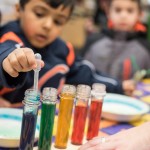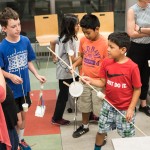We know that hands-on or experiential learning is great for patrons of all ages, and that it’s particularly powerful in STEAM learning opportunities. Skokie Public Library has developed STEAM programming benchmarks for our youth patrons, from pre-kindergarten through grade 5, that ensure we have regular STEAM offerings on a variety of topics. We’ve found that these benchmarks are a great way for us to ensure we’re offering a variety of STEAM program options during each program cycle, and also to think about how we might want to theme our programs around core concepts or disciplines (like space, botany, or architecture). Here’s an overview of what we offer, how often we offer it, and some program examples that can help get you started.
For our youngest learners ages 3-5, we embrace and encourage their natural curiosity with STEAM concepts in a bi-monthly 30 minute program called Science Club Jr. This program is offered during storytime breaks so we can continue the momentum from the storytime session. Youth Services Librarian Gudrun Premier curates programs to include a picture book and hands-on experiment focused on a STEAM topic. Past topics have included kitchen chemistry, where participants made bread in a bag; gardening, where children learned about the plant life cycle before planting seeds; and the solar system, in which they learned about the shapes of celestial bodies.
Like Science Club Jr., Science Club is offered bi-monthly, albeit for grades K-2. The program model is similar and often includes experiment stations rather than one guided experiment. We typically spend 45 minutes in Science Club programs in order to accommodate the longer attention spans of early elementary-age children. Past topics have included states of matter, where we explored slime and oobleck; circuitry, where we designed simple circuits; and the moon, in which we learned about the lunar phases.
For learners across the elementary school range, we offer Mission BOOMbox, a bi-monthly hour-long program for grades K-5 with an adult. These programs are scheduled on Saturdays and are mostly a challenge-based design or engineering activity; we’ve blogged about some of our favorites. Participants are presented with background information on the program topic, given a timed challenge, and then share their experiences at the end. Past challenges include a watercraft design, roller coaster construction, and an escape room.
Learners in grades 3-5 have the opportunity to participate in a monthly Be the Scientist program that focuses on one STEAM topic—often related to our library’s STEAM space, the BOOMbox. Be the Scientist includes background information and discussion with an experiment or design challenge. Participants often work on the experiments and challenges in teams, but we do accommodate individual learning opportunities as well. We’ve blogged about our Community Photowalk program that took learners outdoors. Other topics have included solar energy, where we built and tested solar ovens; and the human brain, where participants were faced with challenges that required them to design and build tools.
Over the summer and during school breaks, we expand our offerings for K-5 to include multi-day boot camps on STEAM topics. These camps have been offered for school-age learners grouped by grades K-2 and 3-5. Boot camps have focused on coding with Scratch Jr. for K-2 as well as Ozobots for grades 3-5. These multi-day camps allow library staff to facilitate a deeper dive into the program topic that leads participants to increased knowledge, skill building, and personal connections.
We developed these benchmarks as our standards for the minimum number of STEAM opportunities we want to offer youth in any given program cycle. We decided on these benchmarks by considering the needs of the community, the balance of all types of programs we strive to offer, and our library’s commitment to STEAM learning as part of our strategic vision. Regardless of the frequency or length of your current STEAM programs, we encourage you to consider what the optimal benchmarks would be for STEAM learning opportunities for youth at your library.






Leave A Comment